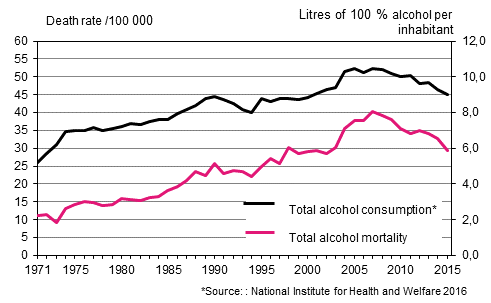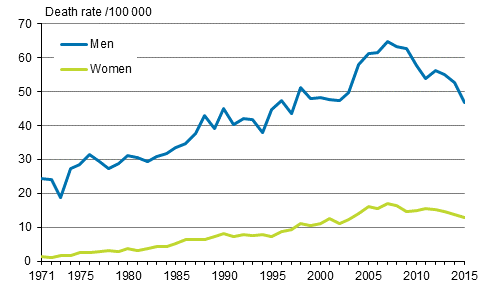4. Alcohol mortality diminished further
Deaths related to the use of alcohol grew relatively evenly in Finland from the 1980s until 2003, after which deaths from alcohol-related causes increased by around one-quarter within a few years. The slow decrease in the number of deaths from alcohol-related causes that started in 2008 continued in 2015. Alcohol mortality in 2015 was almost on level with 2003. In 2015, close on 1,700 persons died from alcohol-related diseases and alcohol poisonings. Of them, around 1,300 were men and 400 women.
The most significant reason for the growth in alcohol mortality in the early 2000s was increased consumption of alcohol. Since 2007, total alcohol consumption has decreased, however. In 2015, converted to 100% alcohol, total consumption was 9.0 litres per capita (National Institute for Health and Welfare 2016). Changes in alcohol-related mortality has followed fairly regularly the graph for total consumption of alcoholic beverages even though alcohol-related deaths usually call for long-term detrimental use of alcohol that lasts for several years. The changes in the number of deaths from alcohol-related causes between 2009 and 2015 were mainly caused by changes in men's deaths from alcohol-related causes.
Several different alcohol-related diseases used as primary causes of death and accidental alcohol poisonings have been collected into alcohol-related causes of death. Diseases related to long-term alcohol use, such as liver and heart diseases, cause a majority of deaths from alcohol-related causes. The share of alcohol poisonings in deaths from alcohol-related causes has decreased from 27 to 16 per cent over a ten-year period. In 2015, altogether 263 persons died from alcohol poisonings, three-quarters of whom were men.
Fewer people die of alcohol-related causes than from neoplasms or diseases of the circulatory system. However, more working-age persons still die of alcohol-related causes than of individual neoplasm types or ischaemic heart diseases. In addition, alcohol is also a contributing factor to death in many fatal accidents (not the primary cause of death). The share of intoxication in accidents will be discussed in the following section.
Figure 6. Age-standardised mortality from alcohol–related diseases and accidental poisonings by alcohol and total consumption of aclohol in 1971 to 2015

Men die from alcohol-related causes considerably more often than women (Figure 7). Male mortality has also followed more closely changes in total consumption of alcohol. Women are lagging behind in alcohol statistics but women's mortality from alcohol-related causes has also risen over several decades following men's mortality from alcohol-related causes. In 2015, alcohol mortality of both men and women was one-fifth lower than in 2005.
Persons who died of alcohol-related causes are older than before. During the past ten years, mortality from alcohol among both men and women aged 65 or over has grown while, correspondingly, in younger age groups mortality from alcohol has decreased. Two-thirds of persons who died of alcohol-related causes are still of working age but alcohol mortality of persons aged over 65 has grown from 17 to 33 per cent over the past ten years. In 2015, the average age of men and women dying of alcohol-related causes was exactly 61.
In 2015, the share of alcohol-related causes in all deaths was only three per cent. Alcohol-related causes are, however, more common causes of death for middle-aged people than for retirement-age people. Of men that died aged 50 to 54 one in four died of alcohol-related causes and among those aged 65 to 69 fewer than one in ten.
Figure 7. Age-standardised mortality from alcohol-related diseases and accidental poisonings by alcohol in 1971 to 2015

Source: Causes of death, Statistics Finland
Inquiries: Airi Pajunen 029 551 3605, Jari Hellanto 029 551 3291, kuolemansyyt@stat.fi
Director in charge: Jari Tarkoma
Updated 30.12.2016
Official Statistics of Finland (OSF):
Causes of death [e-publication].
ISSN=1799-5078. 2015,
4. Alcohol mortality diminished further
. Helsinki: Statistics Finland [referred: 19.4.2025].
Access method: http://stat.fi/til/ksyyt/2015/ksyyt_2015_2016-12-30_kat_004_en.html

